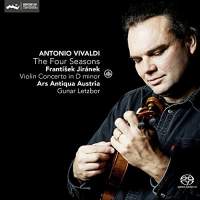Texte paru dans: / Appeared in: |
|
|
Outil de traduction ~ (Très approximatif) |
|
|
Reviewer: Robert
Maxham Gunnar Letzbor expresses in his booklet notes his intention to approach Vivaldi with the freshness of one relatively unfamiliar with the composer’s works and their recent interpretive trends. Has he done so? Consider that in the 1950s, performances by ensembles like the Virtuosi di Roma sounded tame by today’s standards—moderately varied tempos and naturalistic devices that speak for themselves through the normal way of playing instruments, unenhanced by surreal timbral experiments. Many will suspect that that’s the way the music might imprint itself on a tabula rasa, only beginning to explore the eldritch after years of relatively straightforward readings. Does the Letzbor’s dog in the slow movement of Spring sound more realistic on account of the sharp articulation the violist brings to his barks; and does the turtle dove in the concerto’s first movement fool a listener’s ear in Letzbor’s realization? Again, many will suspect that Letzbor has done in the non-pictorial passages just what he decries in his notes—taken the current trends in literal interpretation and pushed them even further into the expressive twilight zone. So the storms in “Spring” and “Summer” batter the listener with rushing wind and driving rain, and the rustic dance in “Spring” thumps with a vitality that’s not entirely ingratiating (he brings a similar bucolic energy to the opening movement of “Autumn”). And like his fellow performers nowadays, he hardly shrinks from producing sounds that in other contexts might be considered harsh or even, on occasion, downright unpleasant. In “Autumn,” too, he engages in dynamic contrasts as surprising and even breathtaking as anything that Il Giardino Armonico might have foisted upon unsuspecting listeners now almost a generation ago, and the hunting calls thump with a vengeance in the last movement. The fleeing prey may not be fooled into thinking that it is being pursued by a string ensemble; but its pursuers’ gunshots sound bring a new, and, this time, welcome and exciting pictorialism to the chase. From the recording by the Academy of St. Martin in the Fields a generation or more ago onwards, it’s become almost a tradition to make the opening repeated notes in “Winter” sound like icicles creaking under the strain of the cold, but Letzbor and the Ars Antiqua Austria whack them hard. In fact, that constant whacking of accents through the set of concertos serves almost as a signature for the performance as a whole; and it hardly lets up in the slow movements, although the rain splashing in the slow movement of the last concerto provides some relief. So, here’s what the performance sounds like: strong dynamic contrasts, high virtuosity, bustling storms, and batteries of regular accents. Is this a performance that, like so many others nowadays, serves almost as meta-performance, referring to other performances as much as to the music itself? For those inured to this kind of thing, Letzbor’s reading, outside, perhaps, of the ensemble’s strong regular accents, provides yet another entry into the growing catalog of performances that once might have seemed to lie almost reprehensibly beyond the pale but have now become almost de rigueur. Still, with recorded sound that renders the performers startlingly present and with its sense of confident exploration, those who like this kind of playing should find its exuberance very much to their tastes. And those who might wish to argue that the performance isn’t derivative might make of Letzbor’s resuscitation of František Jiránek’s concerto a strong counter-argument. Here, the same manner does in fact create a dramatic impression in what might have passed as a less lustrous inspiration. Recommended, therefore, most strongly to those sympathetic to Letzbor’s stylistic presuppositions (one of which appears in his playing these works—especially Vivaldi’s—at A=c. 415, when others often adopt A=440 in deference to the hypothesis that Venetians usually played at that level). | |
|
Support us financially by purchasing this disc from eiher one of these suppliers. FR - U.S. - UK - CA - DE - JA - Un achat via l'un ou l'autre des fournisseurs proposés contribue à défrayer les coûts d'exploitation de ce site. |
|
|
|
|
|
Cliquez l'un ou l'autre
bouton pour découvrir bien d'autres critiques de CD |
|




